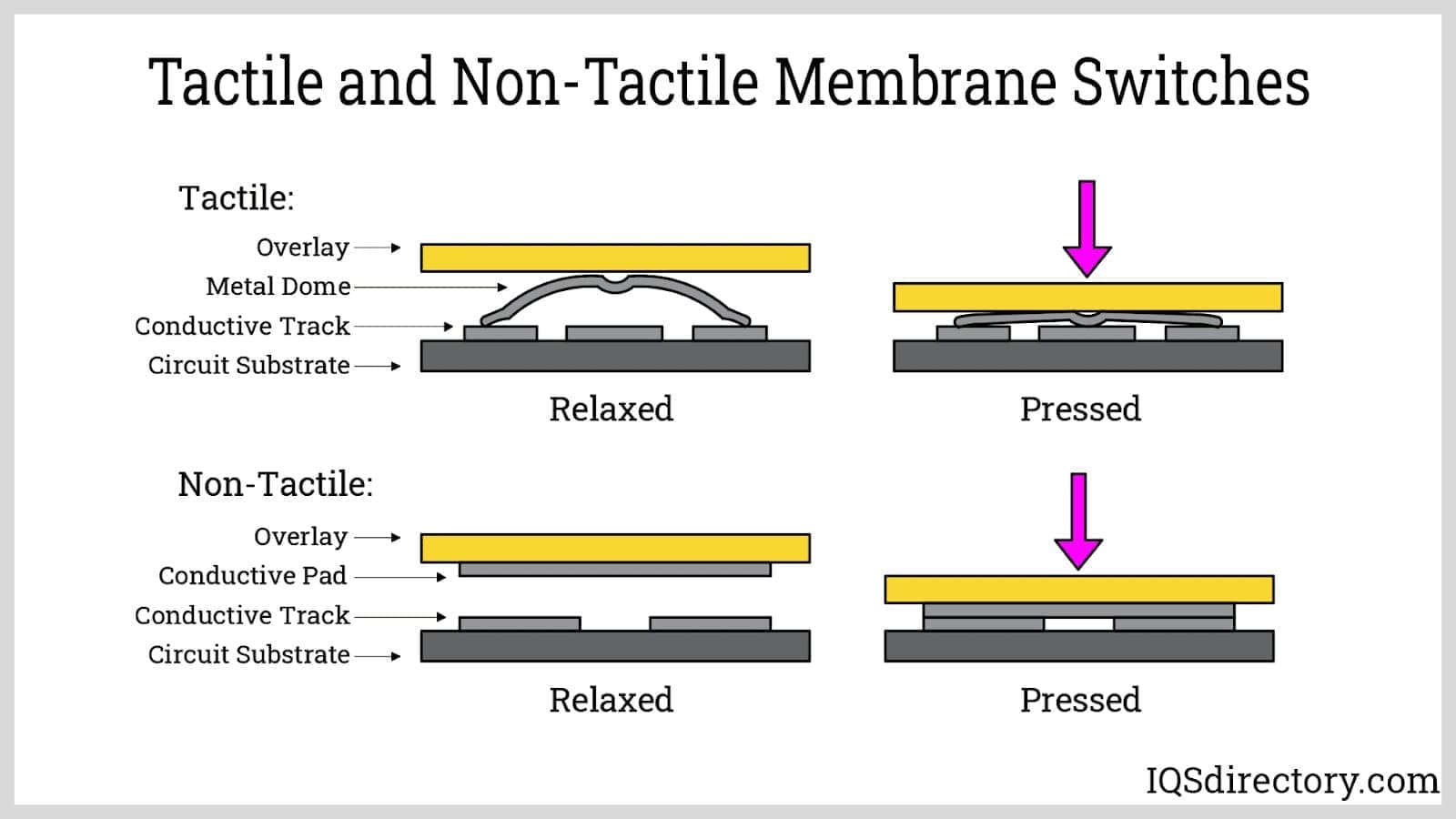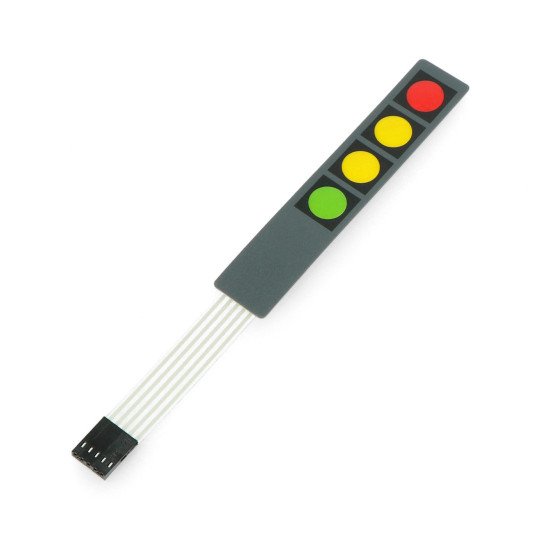Membrane Switch Manufacturer Offering Advanced Engineering Solutions
Membrane Switch Manufacturer Offering Advanced Engineering Solutions
Blog Article
Comprehending the Importance of Membrane Switch in Modern Electronics and Their Applications
Membrane changes work as an important component in contemporary electronic devices, supplying an efficient interface for user communication. Their customizable and lightweight nature makes them suitable for a variety of applications across diverse industries. Understanding their essential elements and advantages can provide insights into their growing importance. As technology continues to development, the advancement of Membrane switches over increases questions regarding their future applications and design innovations. What exists in advance in this vibrant field?

What Are Membrane Buttons?
Membrane buttons are vital elements in modern electronic devices, working as interface that facilitate communication between customers and tools. These buttons consist of numerous layers, including a visuals overlay, a sticky layer, and a circuit layer, all of which interact to develop a functional and sturdy interface. The style enables a flat, inconspicuous option that can be customized pertaining to dimension, shape, and visual look, making them ideal for numerous applications, from customer electronic devices to medical tools. The tactile feedback given by Membrane switches over enhances user experience, while their resistance to dust and moisture makes them perfect for challenging settings. Membrane switches can include functions such as backlighting and published graphics, additionally broadening their functionality. Their versatility and effectiveness make them a preferred option in sectors where dependability and simplicity of use are vital, inevitably adding to the smooth operation of modern-day digital devices.
Secret Elements of Membrane Changes
While various parts add to the functionality of a membrane layer switch, 3 key layers play considerable duties in its layout and operation. The leading layer, usually made from a sturdy polymer, serves as the interface for individual communication, often including printed symbols and graphics. Under this is the spacer layer, which maintains the required range in between the top layer and the circuit layer. This spacer layer guarantees that the button triggers just when pressed, stopping unintended inputs. Lastly, the circuit layer has conductive traces that finish the electrical circuit when the top layer is depressed. These traces can be made from different products, including copper or silver. Together, these parts create a durable and reliable tool that is small and flexible, ideal for a variety of electronic applications, from household home appliances to clinical gadgets. Recognizing these crucial elements is vital for valuing the overall capability of Membrane switches.
Advantages of Using Membrane Switches Over

Membrane Switch Production Refine
Recognizing the Membrane switch production procedure discloses the detailed steps involved in creating these vital elements. The procedure generally starts with the style phase, where specs and formats are produced utilizing specialized software program. Following this, the graphic overlay is printed on a flexible substratum, commonly making use of high-resolution printing methods to ensure clarity and precision.Next, the adhesive layers are used, which offer to bond the numerous components with each other. The circuit layers, made from conductive inks or products, are then printed onto a different substrate. These layers are very carefully aligned and laminated to develop a functional switch.After assembly, the buttons undertake checking to validate performance and toughness. Quality assurance measures are executed throughout the process to determine and fix any defects. Lastly, the completed Membrane switches are packaged and gotten ready for circulation, prepared to satisfy the demands of modern digital applications.
Applications of Membrane Switches in Different Industries
Membrane switches are progressively made use of throughout various industries, especially in clinical devices and consumer electronics. In the medical area, they provide trustworthy control user interfaces for gadgets that require precise procedure. Similarly, in customer electronic devices, these switches improve individual communication by providing receptive and sleek user interfaces.
Medical Devices Control
Countless modern-day medical gadgets make use of Membrane switches for structured procedure and boosted user communication. These switches give a reliable, durable user interface for a range of applications, consisting of diagnostic equipment, patient surveillance systems, and surgical instruments. Their adjustable layouts allow for particular formats that can suit the one-of-a-kind requirements of health care professionals, guaranteeing user-friendly navigation and efficient access to crucial functions. In addition, Membrane buttons are immune to pollutants, making them ideal for clean and sterile settings. The tactile responses they offer can boost customer confidence, lowering the danger of errors throughout vital medical treatments. On the whole, the assimilation of Membrane buttons in medical equipment considerably adds to improved operational effectiveness and client security in health care settings.
Customer Electronics Interfaces
In the domain name of customer electronics, Membrane switches play an important role in boosting interface across a variety of tools. These buttons are indispensable to products such as push-button controls, microwaves, and pc gaming consoles, providing a reliable and easy to use user interface. Their layout permits for a smooth integration of graphics and performance, making it possible for manufacturers to produce smooth, modern aesthetic appeals without compromising usability. Membrane buttons are likewise known for their resilience, frequently holding up against comprehensive use and direct exposure to various environmental problems. In addition, they can integrate functions like backlighting and tactile comments, more improving the individual experience. As consumer demands for advanced yet instinctive user interfaces grow, Membrane switches remain to be a vital component ahead of time digital tool functionality.
Style Considerations for Membrane Switches Over
Creating reliable Membrane changes calls for cautious interest to numerous variables that affect both functionality and user experience. One vital factor to consider is the choice of materials, as they can affect sturdiness, responsive responses, and aesthetic charm. Choosing an ideal adhesive is vital for assuring lasting adhesion and resistance to environmental factors.In addition, the design and style of the button have to suit user interaction, with switch sizes and spacing optimized for see page simplicity of usage. The consolidation of graphics and continue reading this labeling need to prioritize quality and presence under different lighting conditions.Consideration of electric features, such as actuation force and button sensitivity, will enhance the responsiveness of the Membrane switch. The design must fit making procedures to assure cost-effectiveness and prompt manufacturing. Generally, a well-balanced design enhances both the functionality and the user experience of Membrane switches in contemporary electronics.

Future Patterns in Membrane Switch Modern Technology
As modern technology proceeds to advance, Membrane switches are positioned to incorporate brand-new developments that will certainly boost their performance and application in numerous fields. One significant pattern is the consolidation of durable and flexible materials, which will increase the life expectancy and integrity of these buttons. Boosted surface appearances and adjustable graphics are additionally prepared for, enabling for more user-friendly user interfaces.Moreover, the integration of wise innovation, such as touch-sensitive surface areas and haptic responses, is anticipated to boost individual communication, making Membrane switches extra engaging and responsive. Additionally, breakthroughs in published electronic devices will certainly allow more intricate circuitry within thinner accounts, better increasing design possibilities.Sustainability will certainly additionally play a vital duty in future growths, as producers check out environmentally friendly materials and manufacturing procedures. Generally, these trends will guarantee that Membrane changes remain important and appropriate in an interconnected and significantly digital globe.
Frequently Asked Concerns
Just How Do Membrane Switches Compare to Standard Mechanical Buttons?
Membrane switches deal benefits over conventional mechanical buttons, including decreased dimension, lighter weight, and improved resilience. They usually provide a sealed surface, boosting resistance to dirt and dampness, making them suitable for varied applications.
What Products Are Generally Utilized in Membrane Switch Building?

Can Membrane Switches Withstand Extreme Environmental Issues?
Membrane buttons can hold up against extreme ecological problems, relying on their style and materials. Top notch constructions often include toughness against temperature changes, moisture, and exposure to chemicals, making them ideal for various requiring applications across markets.
For How Long Do Membrane Switches Typically Last Prior To Failing?
Membrane switches commonly exhibit a lifespan varying from 1 to 10 million actuations, depending upon elements such as usage frequency, environmental conditions, and manufacturing top quality. Normal maintenance can expand their longevity and functional reliability significantly.
Are Membrane Changes Adjustable for Certain Applications?
Membrane switches are without a doubt adjustable for specific applications. They can be customized in size, functionality, and layout, allowing suppliers to meet unique user requirements and enhance item appearances while keeping functional effectiveness and durability. Membrane buttons are vital components in contemporary electronic devices, offering as individual interfaces that assist in interaction between gadgets and individuals. The tactile comments supplied by Membrane switches over enhances customer experience, while their resistance to dirt and wetness makes them perfect for testing environments. The incorporation of graphics and labeling must focus on clearness and presence under numerous illumination conditions.Consideration of electrical characteristics, such as actuation pressure and button level of sensitivity, will certainly improve the responsiveness of the Membrane switch. Improved surface appearances and customizable graphics are additionally prepared for, permitting for even more intuitive user interfaces.Moreover, the combination of wise innovation, such as touch-sensitive surfaces and haptic feedback, is anticipated to improve individual communication, making Membrane switches much more appealing and responsive. Membrane switches offer advantages over standard mechanical buttons, consisting of minimized size, lighter weight, and improved resilience.
Report this page